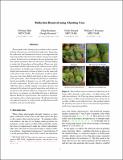| dc.contributor.author | Krishnan, Dilip | |
| dc.contributor.author | Shih, YiChang | |
| dc.contributor.author | Durand, Frederic | |
| dc.contributor.author | Freeman, William T. | |
| dc.date.accessioned | 2018-02-20T14:42:52Z | |
| dc.date.available | 2018-02-20T14:42:52Z | |
| dc.date.issued | 2015-10 | |
| dc.date.submitted | 2015-06 | |
| dc.identifier.isbn | 978-1-4673-6964-0 | |
| dc.identifier.uri | http://hdl.handle.net/1721.1/113822 | |
| dc.description.abstract | Photographs taken through glass windows often contain both the desired scene and undesired reflections. Separating the reflection and transmission layers is an important but ill-posed problem that has both aesthetic and practical applications. In this work, we introduce the use of ghosting cues that exploit asymmetry between the layers, thereby helping to reduce the ill-posedness of the problem. These cues arise from shifted double reflections of the reflected scene off the glass surface. In double-pane windows, each pane reflects shifted and attenuated versions of objects on the same side of the glass as the camera. For single-pane windows, ghosting cues arise from shifted reflections on the two surfaces of the glass pane. Even though the ghosting is sometimes barely perceptible by humans, we can still exploit the cue for layer separation. In this work, we model the ghosted reflection using a double-impulse convolution kernel, and automatically estimate the spatial separation and relative attenuation of the ghosted reflection components. To separate the layers, we propose an algorithm that uses a Gaussian Mixture Model for regularization. Our method is automatic and requires only a single input image. We demonstrate that our approach removes a large fraction of reflections on both synthetic and real-world inputs. | en_US |
| dc.description.sponsorship | Quanta Computer (Firm) | en_US |
| dc.description.sponsorship | Qatar Computing Research Institute | en_US |
| dc.language.iso | en_US | |
| dc.publisher | Institute of Electrical and Electronics Engineers (IEEE) | en_US |
| dc.relation.isversionof | http://dx.doi.org/10.1109/CVPR.2015.7298939 | en_US |
| dc.rights | Creative Commons Attribution-Noncommercial-Share Alike | en_US |
| dc.rights.uri | http://creativecommons.org/licenses/by-nc-sa/4.0/ | en_US |
| dc.source | MIT Web Domain | en_US |
| dc.title | Reflection removal using ghosting cues | en_US |
| dc.type | Article | en_US |
| dc.identifier.citation | YiChang Shih, et al. "Reflection Removal Using Ghosting Cues." 2015 IEEE Conference on Computer Vision and Pattern Recognition (CVPR), 7-12 June 2015, Boston, Massachusetts, IEEE, 2015, pp. 3193–201. | en_US |
| dc.contributor.department | Massachusetts Institute of Technology. Computer Science and Artificial Intelligence Laboratory | en_US |
| dc.contributor.department | Massachusetts Institute of Technology. Department of Electrical Engineering and Computer Science | en_US |
| dc.contributor.mitauthor | Shih, YiChang | |
| dc.contributor.mitauthor | Durand, Frederic | |
| dc.contributor.mitauthor | Freeman, William T. | |
| dc.relation.journal | 2015 IEEE Conference on Computer Vision and Pattern Recognition (CVPR) | en_US |
| dc.eprint.version | Author's final manuscript | en_US |
| dc.type.uri | http://purl.org/eprint/type/ConferencePaper | en_US |
| eprint.status | http://purl.org/eprint/status/NonPeerReviewed | en_US |
| dspace.orderedauthors | YiChang Shih; Krishnan, Dilip; Durand, Fredo; Freeman, William T. | en_US |
| dspace.embargo.terms | N | en_US |
| dc.identifier.orcid | https://orcid.org/0000-0001-9919-069X | |
| dc.identifier.orcid | https://orcid.org/0000-0002-2231-7995 | |
| dspace.mitauthor.error | true | |
| mit.license | OPEN_ACCESS_POLICY | en_US |
